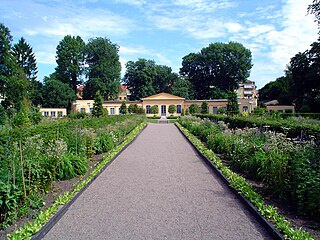
The International Code of Nomenclature for algae, fungi, and plants is the set of rules and recommendations dealing with the formal botanical names that are given to plants, fungi and a few other groups of organisms, all those "traditionally treated as algae, fungi, or plants". It was formerly called the International Code of Botanical Nomenclature (ICBN); the name was changed at the International Botanical Congress in Melbourne in July 2011 as part of the Melbourne Code which replaced the Vienna Code of 2005.
Francis BuchananFRSE FRS FLS, later known as Francis Hamilton but often referred to as Francis Buchanan-Hamilton, was a Scottish surgeon, surveyor and botanist who made significant contributions as a geographer and zoologist while living in India. He did not assume the name of Hamilton until three years after his retirement from India.

William Roxburgh FRSE FRCPE FLS was a Scottish surgeon and botanist who worked extensively in India, describing species and working on economic botany. He is known as the founding father of Indian botany. He published numerous works on Indian botany, illustrated by careful drawings made by Indian artists and accompanied by taxonomic descriptions of many plant species. Apart from the numerous species that he named, many species were named in his honour by his collaborators.

Alexander Dalrymple FRS was a Scottish geographer and the first Hydrographer of the British Admiralty. He was the main proponent of the theory that there existed a vast undiscovered continent in the South Pacific, Terra Australis Incognita. He produced thousands of nautical charts, mapping a remarkable number of seas and oceans for the first time, and contributing significantly to the safety of shipping. His theories prompted a number of expeditions in search of this mythical land, until James Cook's second journey (1772–1775) led to the conclusion that, if it did exist, it was further south than the 65° line of latitude South.
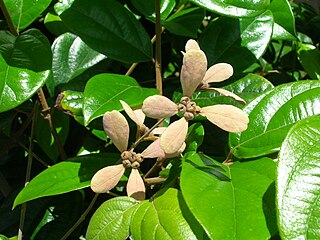
Congea is a small genus of flowering plants in the mint family, Lamiaceae, first described by William Roxburgh in 1820.

Caralluma is a genus of flowering plants in the family Apocynaceae, consisting of about 120 species.

Careya arborea is a species of tree in the Lecythidaceae family, native to the Indian subcontinent, Afghanistan, and Indochina. Its common English names include wild guava, Ceylon oak, patana oak. Careya arborea is a deciduous tree that grows up to 15 metres (49 ft) high. Its leaves turn red in the cold season. Flowers are yellow or white in colour that become large green berries. The tree grows throughout India in forests and grasslands.

Phoenix acaulis the dwarf date palm or stemless date palm, is a species of flowering plant in the palm family, native to northern India, Bhutan and Nepal. Found in altitudes from 350 to 1500 m, Phoenix acaulis grows in scrubland, savannas and in pine forests. Trunks in this species remain underground or, at most, grow to a few inches in height. Leaves are 1.5 m long, gray-green, with 25 cm, pinnately arranged leaflets on short, armed petioles.
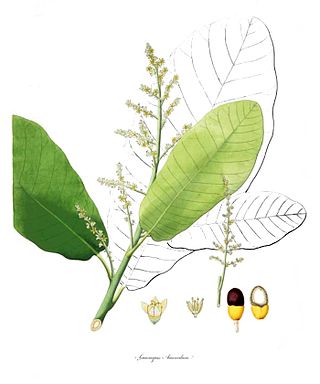
Semecarpus is a genus of plants in the family Anacardiaceae. It includes 87 species native to the Indian subcontinent, Indochina, Malesia, Taiwan, Papuasia, Queensland, and the South Pacific.

Willughbeia is a genus of plant in the family Apocynaceae, first described as a genus in 1820. It is native to Southeast Asia with a few species in the Indian Subcontinent. Several species have edible fruits enjoyed in many countries. Many species are vines with sticky latex.
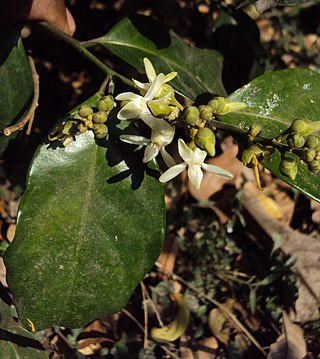
Xanthophyllum is a genus of about 109 species of trees and shrubs, of the plant family Polygalaceae;. The generic name is from the Greek meaning "yellow leaf", referring to how the leaves are often yellow when dry. In Borneo it is known as minyak berok in Malay or nyalin in the Iban language.
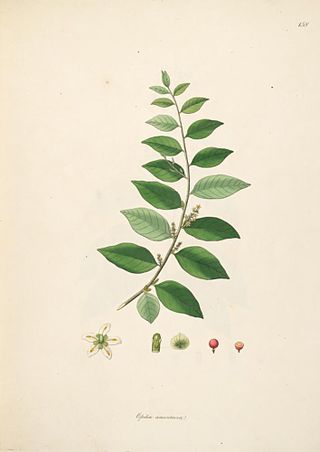
Opilia is a genus of approximately 33 species of lianas in the family Opiliaceae described as a genus in 1802.

Aerides multiflora, the multi-flowered aerides, is a species of orchid, native to Southeast Asia, the Coromandel Coast, and Bangladesh.
Galium hardhamiae is a species of flowering plant in the coffee family Rubiaceae, known by the common name Hardham's bedstraw. The scientific name may be misspelled Galium hardhamae. It is endemic to the Santa Lucia Range of southern Monterey County and northern San Luis Obispo County in California. It is a member of the serpentine soils flora in these coastal mountains. This is a perennial herb forming mats or clumps of stems no more than 30 centimeters long. The stems have many whorls of six fleshy green leaves, each leaf just 1 to 3 millimeters long. The inflorescences, clusters of yellow-green to pinkish flowers, appear in leaf axils.
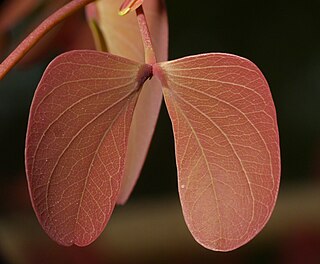
Hardwickia is a monotypic genus of flowering plant in the subfamily Detarioideae of the legumes. The only species is the anjan, Hardwickia binata, a tree which is native to India and Bangladesh, and which grows to height of 25-30 meters. This plant genus was named after Thomas Hardwicke by William Roxburgh.
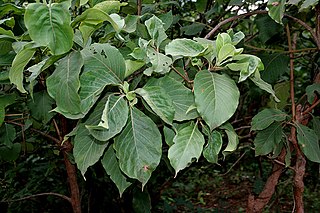
Hymenodictyon is a genus of flowering plants in the family Rubiaceae. It has about 30 species. All are native to the Old World. The wood of Hymenodictyon orixense is soft and has limited use, mostly for boxes. The type species for Hymenodictyon is Hymenodictyon orixense.
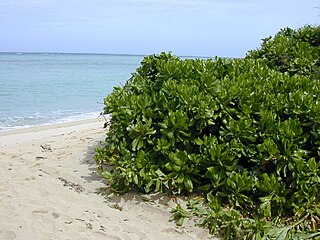
Scaevola taccada, also known as beach cabbage, sea lettuce, or beach naupaka, is a flowering plant in the family Goodeniaceae found in mangrove swamps and rocky or sandy coastal locations in the tropical areas of the Indo-Pacific. It is a common beach shrub throughout the Arabian Sea, the tropical Indian Ocean and the tropical islands of the Pacific Ocean.

Elaeocarpus lanceifolius is a tree species in the family Elaeocarpaceae. It is found across tropical Asia from Thailand to Yunnan to Nepal to Karnataka, India. It is used for its wood, fruit, and nuts.
Cyperus digitatus, also known as finger flatsedge in the United States, and chang xiao sui suo cao in China, is a sedge of the family Cyperaceae that is native to tropical and subtropical areas of Africa, Asia, the Americas and Australia.

Kydia is a genus of flowering plants in the family Malvaceae, found in the Indian subcontinent, southern China and Southeast Asia. Some sources consider it to be monotypic, with Kydia calycina the only species; certainly K. calycina is the best‑studied species, as it is widely exploited, even cultivated, for timber and fiber.

















